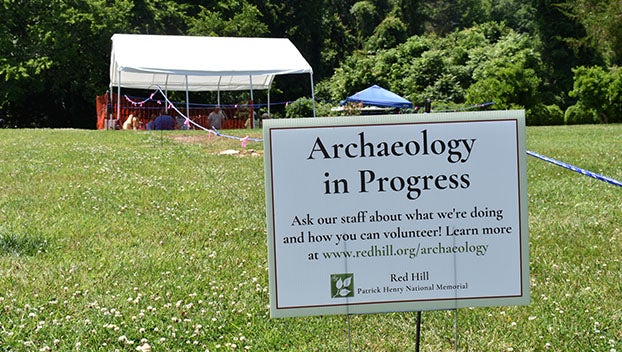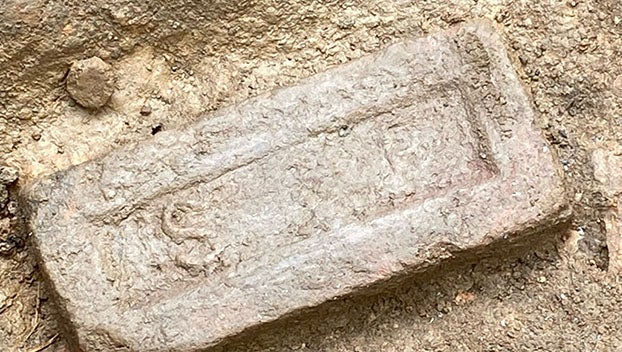Red Hill explores history: New archeological dig uncovers the past
Published 12:26 pm Saturday, October 7, 2023

- The first the first in-house archaeological dig at Red Hill is wrapping up. Photo courtesy of Red Hill.
|
Getting your Trinity Audio player ready...
|
The first summer of an archaeological dig at Red Hill that hopes to uncover the look of the landscape and determine more on how it was used is wrapping as autumn approaches at the Patrick Henry National Memorial.
Red Hill Staff Archaeologist Lucia Butler said this 2023 dig marks the property’s first in-house archaeological investigation and the start of an archaeology program that they hope will continue to also answer and identify questions the people who lived on it through time.
“This summer’s investigation focused on an area where a 1930s servant’s house and an earlier kitchen once stood,” Butler said in a Monday, Oct. 2 interview. “By excavating this site, we were hoping to find out more about those buildings, the people who lived and worked there, and what Red Hill was like in the first half of the 20th century.”
She said the historic site put out a call to volunteers to help with digging. More than 40 people from all age groups responded and joined in on the effort.
“Volunteers learned about the history of the servant’s house and kitchen, participated in excavating the units, sifted dirt for artifacts and helped record what was done each day,” Butler explained.
The decision to begin the dig at the servant’s house and kitchen area grew out of a desire to learn more about the history tied to those buildings and the period of sharecropping on the property.
“The houses where sharecroppers and domestic servants lived in the early 20th century no longer exist on the property,” she said, “but their work is still a part of Red Hill’s history that should be explored and shared.”
The Red Hill dig goal
The goal of Red Hill’s archaeology effort is to understand more about how the landscape looked and was used throughout its history, which Butler said makes it important to investigate these sites.
Prior to the start of this summer’s dig, three 5-foot by 5-foot square test units with one revealing a deep layer of disturbed soil that the Red Hill website explains is an indication that a large feature was dug into the ground and filled back in. Bricks, brick fragments, glass, nails, ceramic, some prehistoric lithics, two metal hooks, a few buttons, a bottle neck with a glass stopper, a sink drain and several unidentified metal objects were uncovered in this test dig.
But Butler explained it was what they didn’t find there that led them to change their strategy about expanding the Red Hill digs. They did not find structural foundations.
“Documentary evidence found later showed us that those foundations were removed during the building’s demolition in the 1960s,” she said.
They went as far as they could in the first units before getting into undisturbed subsoil, which is where Butler said the archaeology stops.
“The three test units gave us a pretty good idea of what we would find across that site. So instead of expanding excavation in the site, we decided to turn our efforts toward a shovel test pit survey,” Butler said. “This survey involves digging small pits across evenly-spaced intervals to give us an idea of soil profiles and artifacts across a larger area to help guide future archaeology.”
What was found
Among the finds on those locations this summer, she said the most common items found were bricks, nails, glass and ceramic items.
“Some of the ceramics found included patterns that we may be able to date, and one of the bricks had stamped initials that we may be able to trace to a brickmaker,” Butler said.
In one of the last shovel test pits, she said they found the reed plate of a harmonica.
“We occasionally came across artifacts from Native American occupation of this site, before Red Hill was a plantation,” she noted. “These included stone tools, such as a scraper, and quartz flakes, which are byproducts of flintknapping.”
Further analysis is planned for all artifacts in the archaeology lab at Red Hill.
As they do wrap up the field season of the dig with fall here, work now moves to that lab for investigation and artifact processing.
“This involves cleaning artifacts, labeling them, entering their information into a database, and packaging them for storage,” she said. “This work will take place in Red Hill’s archaeology lab, which is being set up in the new administrative building down the street from the historic site.”
Butler said volunteers can again get involved with the project later this fall as part of artifact processing.
“Next summer, we will investigate a different area of the property,” she said. “We are still discussing where to focus next year’s work, but we will share updates as we finalize the research design, including information about volunteer opportunities.”
How can I get involved?
Anyone interested in volunteering with Red Hill’s archaeology program can reach out to Butler at lucia@redhill.org.
Some of the archaeological artifacts are already on display in the museum in the Visitor Center, as well as in our newest exhibition, “The Price of Chains and Slavery,” located in the exhibit cabin on the Quarter Place Trail, she said.
“As we’re developing our lab space, we’re working on finding ways to display processed artifacts for the public,” Butler added.
While this is the first in-house archaeological investigation at Red Hill, there have been several previous ones conducted by cultural resource management specialists and colleges. Most recently in 2020, she said Longwood University’s Institute of Archaeology did research at the Quarter Place, which greatly contributed to our interpretation of the African American cemetery. Other previous investigations have explored areas such as the greenhouse site and the location of a brick clamp.
Patrick Henry’s Red Hill is located at 1250 Red Hill Rd. in Brookneal. Hours through October are 9 a.m. to 5 p.m. Monday-Saturday and 1-5 p.m. Sunday. Additional information on the Patrick Henry National Memorial can be found online at RedHill.org or by calling 434-376-2044.
Editor’s note: Jeff Moore wrote this story for the Charlotte Gazette.




